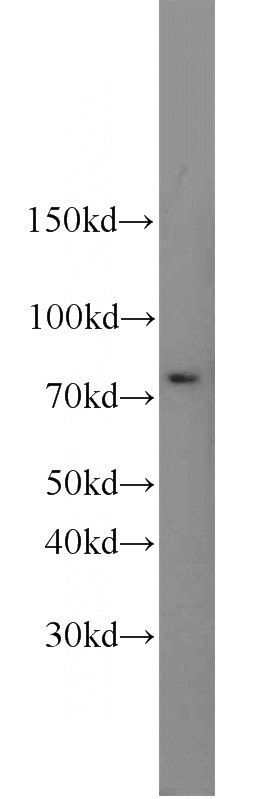-
Product Name
SUMO1 antibody
- Documents
-
Description
SUMO1 Rabbit Polyclonal antibody. Positive WB detected in NIH/3T3 cells, mouse spleen tissue. Observed molecular weight by Western-blot: 10-12 kDa,80-90 kDa
-
Tested applications
ELISA, WB
-
Species reactivity
Human,Mouse,Rat; other species not tested.
-
Alternative names
DAP 1 antibody; GAP modifying protein 1 antibody; GMP1 antibody; OFC10 antibody; PIC1 antibody; SENP2 antibody; Sentrin antibody; SMT3 antibody; SMT3 homolog 3 antibody; SMT3C antibody; SMT3H3 antibody; SUMO 1 antibody; SUMO1 antibody; Ubiquitin like protein SMT3C antibody; Ubiquitin like protein UBL1 antibody; UBL1 antibody
-
Isotype
Rabbit IgG
-
Preparation
This antibody was obtained by immunization of SUMO1 recombinant protein (Accession Number: NM_001005781). Purification method: Antigen affinity purified.
-
Clonality
Polyclonal
-
Formulation
PBS with 0.1% sodium azide and 50% glycerol pH 7.3.
-
Storage instructions
Store at -20℃. DO NOT ALIQUOT
-
Applications
Recommended Dilution:
WB: 1:200-1:2000
-
Validations

NIH/3T3 cells were subjected to SDS PAGE followed by western blot with Catalog No:115836(SUMO1 antibody) at dilution of 1:600
-
Background
Ubiquitin is most famous for its function in targeting proteins for degradation by the 26S proteasome, ubiquitin needs to be attached to a substrate in chains (polyubiquitylation) before being recognized by proteasome. Similarly, SUMO (small ubiquitin-related modifier) can be linked to substrates in chains (polysumoylation), SUMO modification has been implicated in many important cellular processes including the control of genome stability, signal transduction, targeting to and formation of nuclear compartments, cell cycle and meiosis. There are 4 confirmed SUMO isoforms in human, SUMO-1, SUMO-2, SUMO-3 and SUMO-4. SUMO-2 and SUMO-3 are nearly identical but are distinct from SUMO-1. SUMO2/3 conjugation was recently widely involved in neuroprotective activities. A substitution (M55V) of SUMO4 was strongly associated with the pathogenesis of type 1 diabetes (T1D) involving NF kappa B related mechanisms.This antibody can detect endogenous levels of SUMOylated proteins (e.g. SUMO-1-RanGAP at 80-90 kD).
Related Products / Services
Please note: All products are "FOR RESEARCH USE ONLY AND ARE NOT INTENDED FOR DIAGNOSTIC OR THERAPEUTIC USE"
